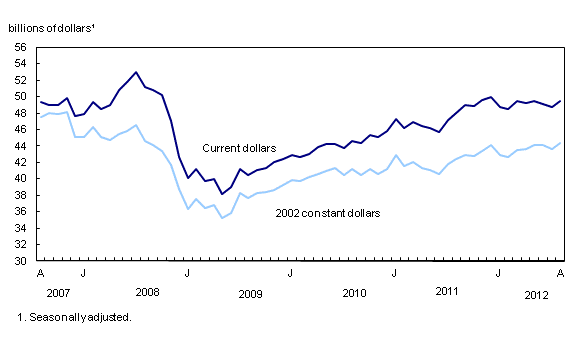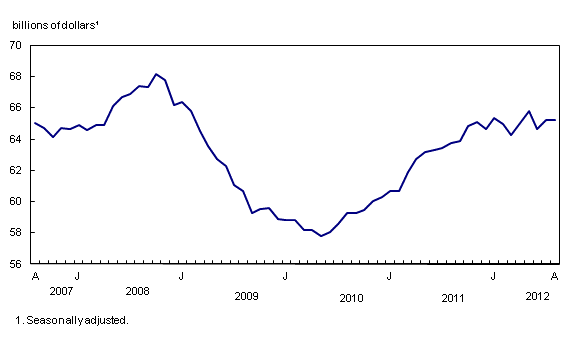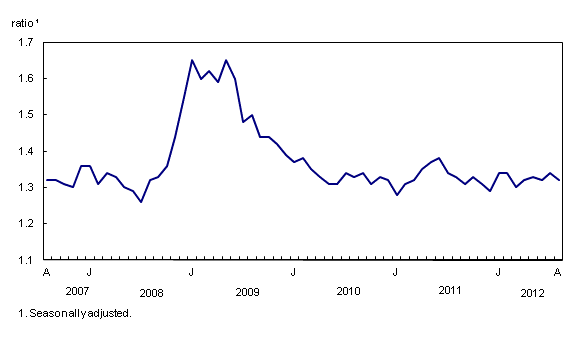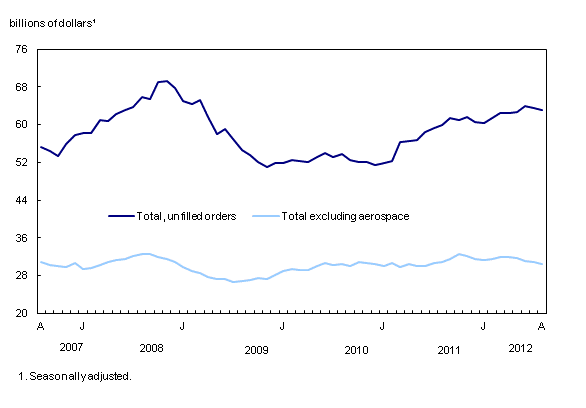Monthly Survey of Manufacturing, August 2012
Archived Content
Information identified as archived is provided for reference, research or recordkeeping purposes. It is not subject to the Government of Canada Web Standards and has not been altered or updated since it was archived. Please "contact us" to request a format other than those available.
Related subjects
-
[an error occurred while processing this directive]
Manufacturing sales increased 1.5% to $49.5 billion in August, the highest sales level since March 2012. The gain largely reflected increases in the petroleum and coal products, and motor vehicle industries.
Manufacturers in 11 out of 21 industries reported higher sales, representing over three quarters of total manufacturing.
Constant dollar sales were up 1.8% in August, indicating a gain in the volume of manufactured goods sold.
Manufacturing sales increase

Chart description: Manufacturing sales increase
Sales advance in the petroleum and coal product industry
In the petroleum and coal product industry, sales advanced 8.6% to $6.8 billion. The increase partly stemmed from higher sales at some refineries following slowdowns for maintenance and retooling work (please see Note to readers for additional information). Prices in the industry rose in August according to the Industrial Product Price Index. The sales increase in the petroleum and coal products industry was the fifth rise in eight months. Notwithstanding the gain in August, sales remained below their most recent peak of $7.5 billion reached in March 2012.
Sales rose 4.4% to $4.7 billion in the motor vehicle assembly industry. The gain stemmed from larger than usual seasonal increases at some plants following regularly scheduled shutdowns in July. The increase was the 12th in 14 months.
A 3.1% sales decrease to $3.7 billion in the primary metal industry partly offset the overall gain in total manufacturing. The decrease mostly reflected lower prices for primary metals in August.
Sales gains concentrated in Ontario and New Brunswick
Higher sales were reported in eight provinces in August. However, most of the gains were concentrated in Ontario and New Brunswick. Manitoba and Quebec were the two provinces with sales declines in August.
In Ontario, sales were up 2.5% to $23.1 billion. Advances in the petroleum and coal products industry accounted for almost half of the provincial increase, as refineries ramped up to full production after partial shutdowns. In the motor vehicle industry, sales were up 4.7% to $4.6 billion, reflecting stronger than normal increases following regularly scheduled shutdowns at some plants. Sales rose 7.2% in the machinery industry to $1.4 billion, contributing to the overall provincial advance.
Manufacturing sales in New Brunswick rose 7.8% to $1.7 billion in August, reflecting gains in the non-durable goods industries. The increase was the fifth for the province in seven months.
In Alberta, sales rose 0.5% to $6.2 billion. The rise stemmed from higher sales in the food (+4.1%) and chemical (+2.6%) industries. These increases were partly offset by declines in the machinery industry (-6.5%).
Manufacturers in Manitoba reported a 4.7% decrease to $1.3 billion in August. Lower sales of durable goods, such as machinery and transportation equipment industries, were responsible for the provincial decrease.
In Quebec, sales edged down 0.3% to $11.2 billion, partly reflecting declines in the fabricated metal product (-12.7%) and primary metal (-3.5%) industries. An 11.0% gain in the transportation equipment industry and a 6.5% rise in the petroleum and coal products industry mostly offset the declines.
Inventories edge down
Manufacturers' inventories edged down 0.1% in August to $65.2 billion. Inventories fell in 14 of 21 industries, but the decreases were largely offset by higher inventories of petroleum and coal products.
The largest declines in inventories were in the aerospace product and parts (-3.2%), computer and electronic products (-4.1%), fabricated metal product (-2.5%) and primary metal product (-1.7%) industries.
A 10.4% rise in petroleum and coal products inventories partly stemmed from higher finished product inventories reported by most refineries. The gain in inventories in August followed two months of declines.
Inventories edge down

Chart description: Inventories edge down
The inventory-to-sales ratio decreased from 1.34 in July to 1.32 in August. The inventory-to-sales ratio is a measure of the time, in months, that would be required to exhaust inventories if sales were to remain at their current level.
The inventory-to-sales ratio declines

Chart description: The inventory-to-sales ratio declines
Unfilled orders decline
Unfilled orders dropped 0.7% in August to $63.1 billion. A decline in the aerospace product and parts industry was responsible for approximately one-third of the decrease.
In the aerospace product and parts industry, unfilled orders were down 0.5% to $32.6 billion. The decrease was attributable to an increase in the value of the Canadian dollar relative to the US dollar in August. A large portion of unfilled orders in this industry are held in US dollars.
Unfilled orders were down 1.5% in the machinery industry to $8.0 billion, reflecting a widespread decrease in the backlog of orders.
In the primary metal and fabricated metal product industries, unfilled orders declined 6.9% and 1.3% respectively.
Unfilled orders decline

Chart description: Unfilled orders decline
In August, new orders increased 1.4% to $49.0 billion, reflecting gains in the petroleum and coal products and motor vehicle industries. Declines in the primary metal, and computer and electronic product industries offset a portion of the gains.
Note to readers
In the petroleum and coal product industry, between April and June 2012, there were partial shutdowns at several plants for retooling and maintenance work, resulting in decreases in reported sales. Production returned to more normal levels by July and August as the work was completed. However, as of this release, the reported sales data received from several refineries are under review, which resulted in changes to July and may result in subsequent revisions to this industry. Readers are advised to use the sales figures with caution.
Preliminary data are provided for the current reference month. Results for the three previous months are revised based on late or updated respondent data.
All data in this release are seasonally adjusted and are expressed in current dollars unless otherwise specified. For more information on seasonal adjustment, see Seasonal adjustment and identifying economic trends.
Non-durable goods industries include food, beverage and tobacco products, textile mills, textile product mills, clothing, leather and allied products, paper, printing and related support activities, petroleum and coal products, chemicals, and plastics and rubber products.
Durable goods industries include wood products, non-metallic mineral products, primary metal, fabricated metal products, machinery, computer and electronic products, electrical equipment, appliances and components, transportation equipment, furniture and related products and miscellaneous manufacturing.
Production-based industries
For the aerospace industry and shipbuilding industries, the value of production is used instead of sales of goods manufactured. This value is calculated by adjusting monthly sales of goods manufactured by the monthly change in inventories of goods in process and finished products manufactured.
Unfilled orders are a stock of orders that will contribute to future sales assuming that the orders are not cancelled.
New orders are those received whether sold in the current month or not. New orders are measured as the sum of sales for the current month plus the change in unfilled orders from the previous month to the current month.
Available without charge in CANSIM: tables CANSIM table304-0014, CANSIM table304-0015 and CANSIM table377-0008.
Definitions, data sources and methods: survey number survey number2101.
Data from the September Monthly Survey of Manufacturing will be released on November 15.
For further information regarding the Monthly Survey of Manufacturing, contact Statistics Canada's National Contact Centre (613-951-8116; toll-free 1-800-263-1136; infostats@statcan.gc.ca).
To enquire about the concepts, methods or data quality of this release, contact Michael Schimpf (613-951-9832; michael.schimpf@statcan.gc.ca) or Jeff Paul (613-951-7328; jeff.paul@statcan.gc.ca), Manufacturing and Energy Division.
- Date modified:
